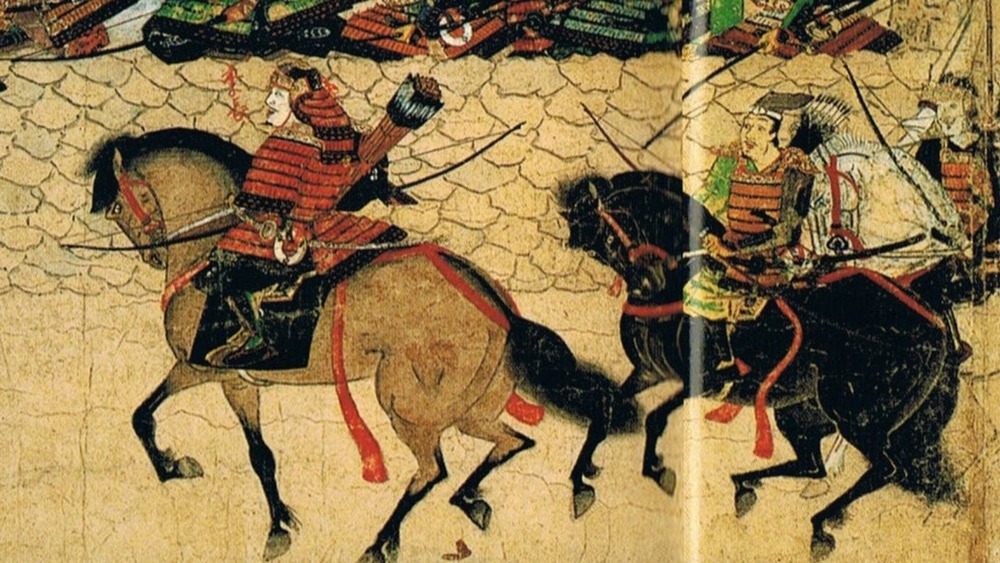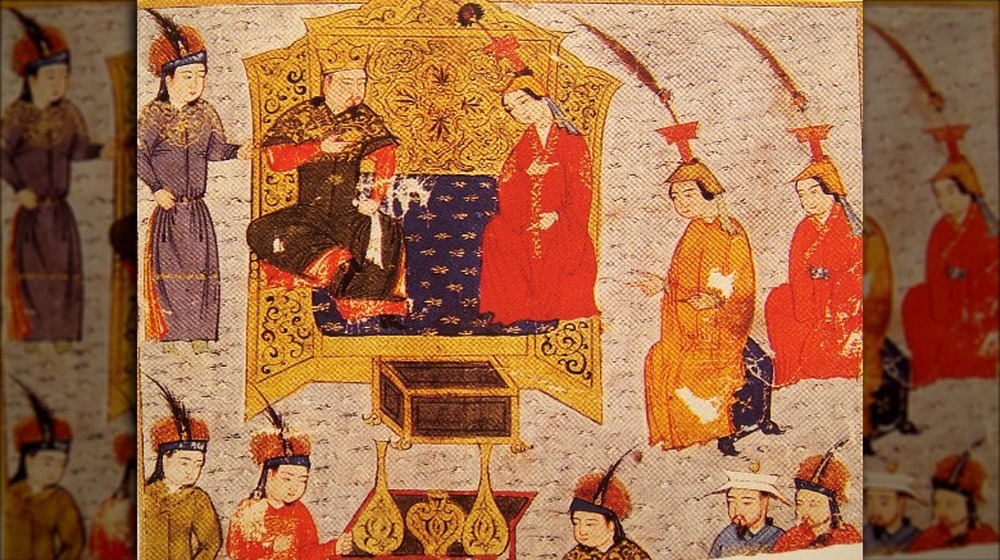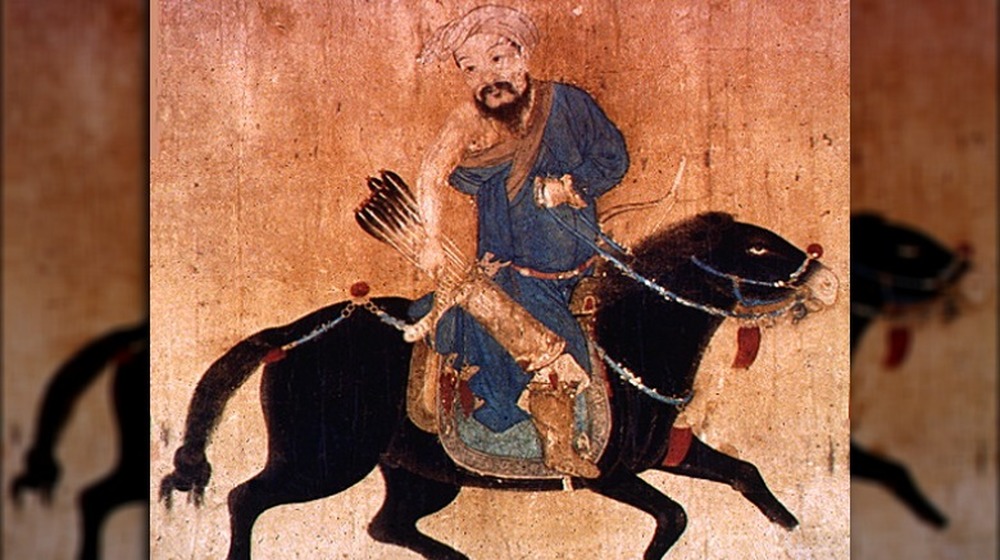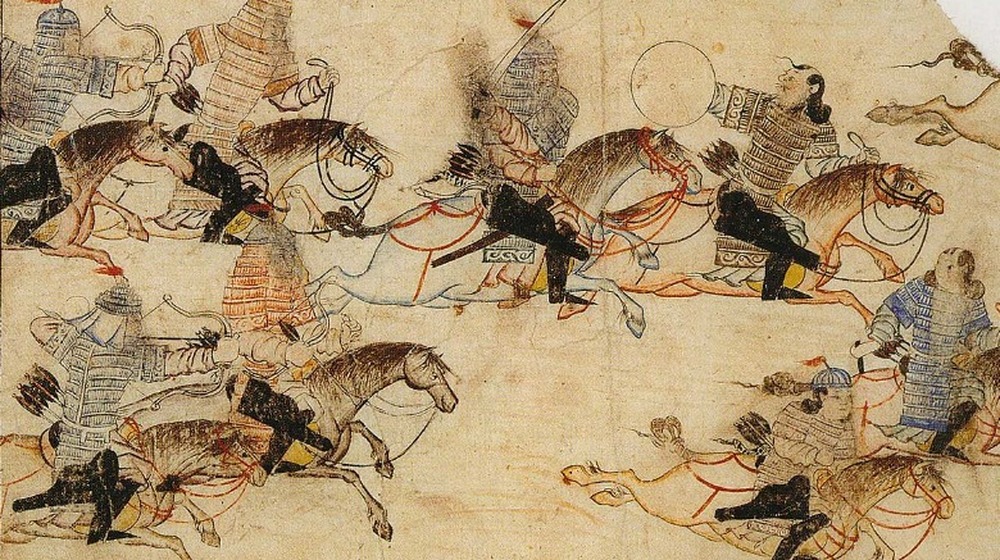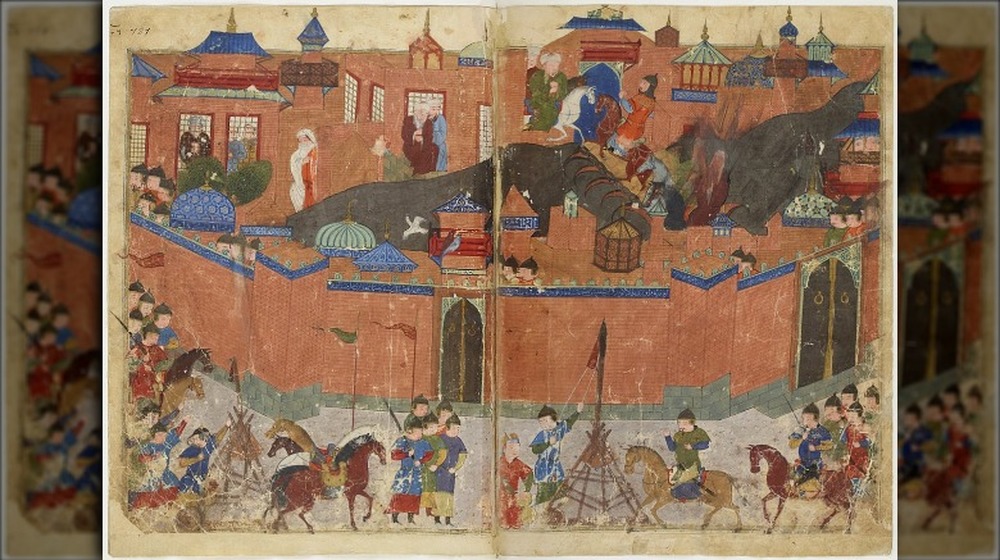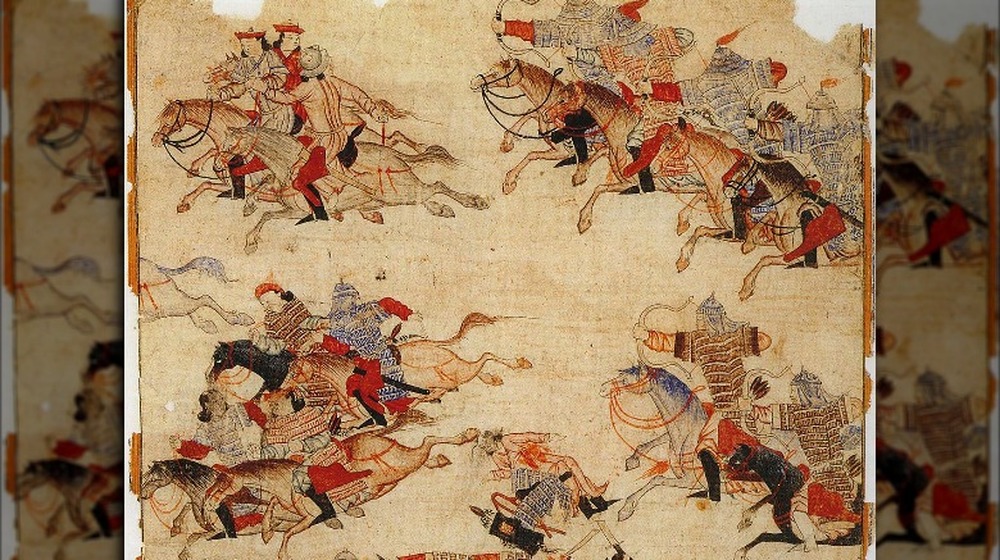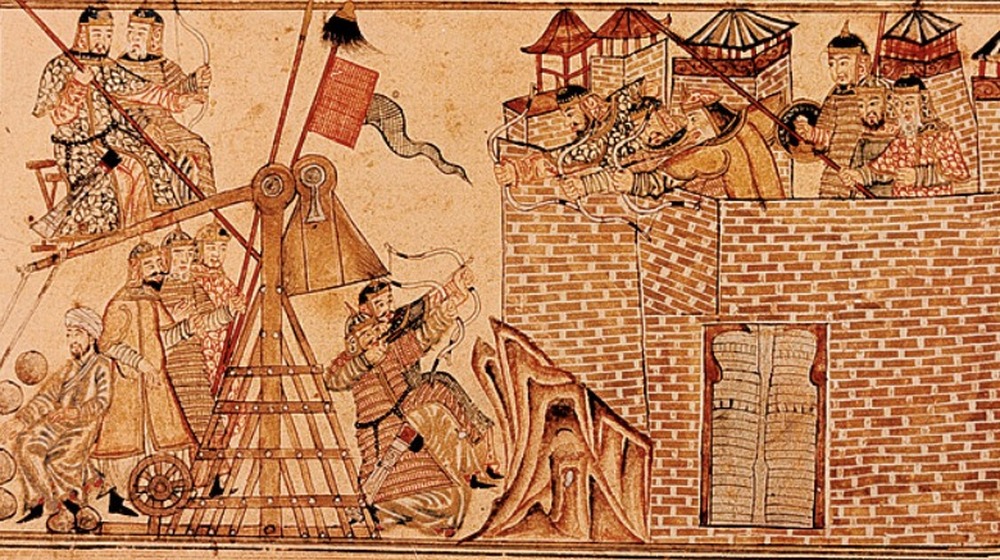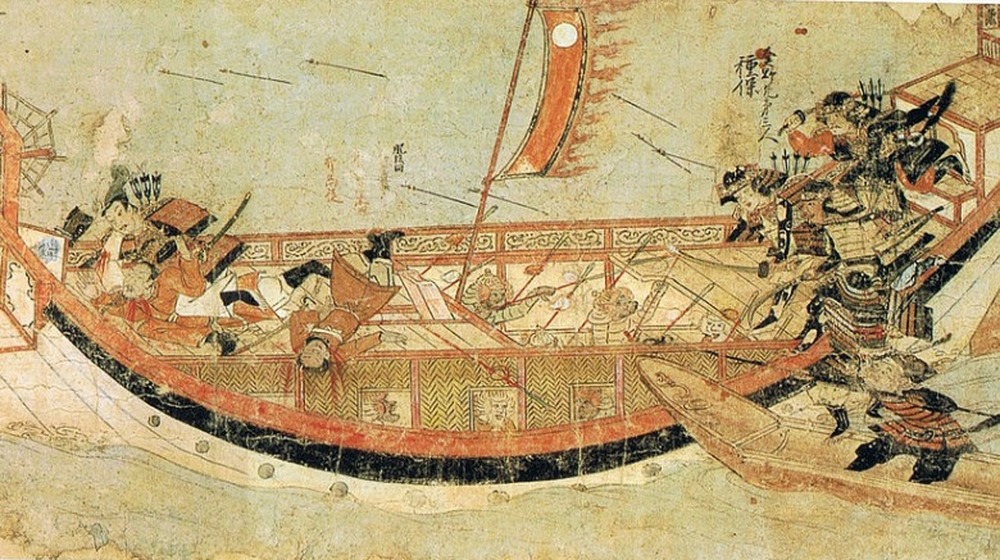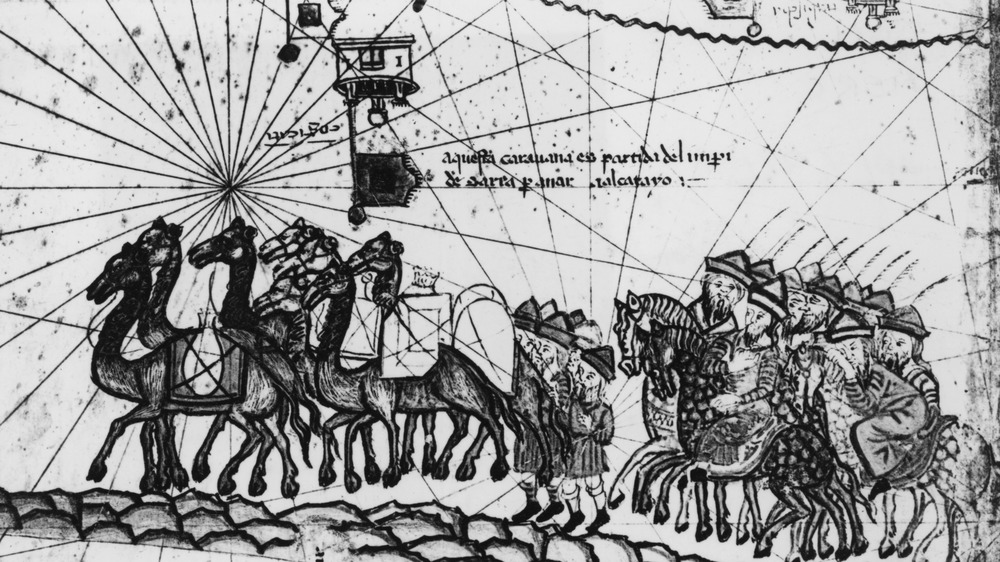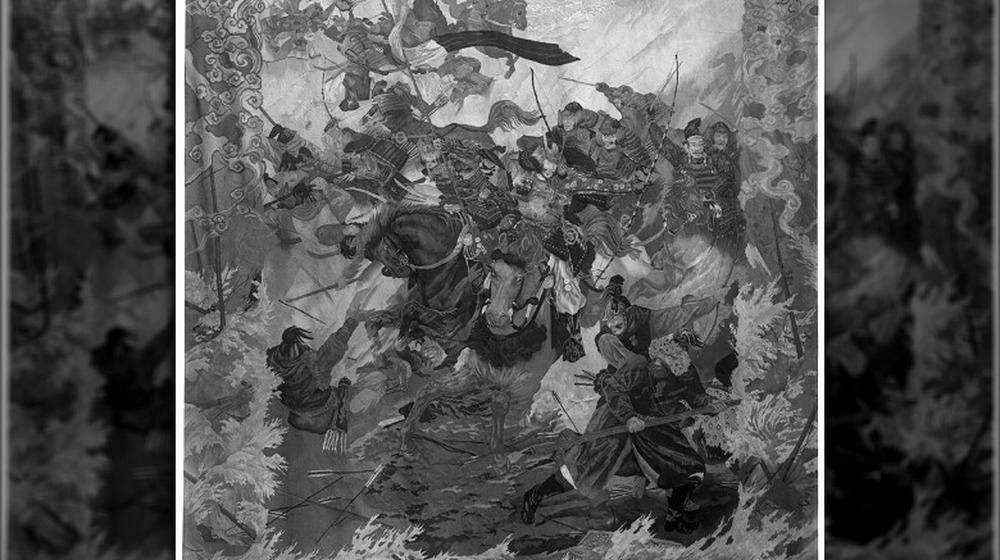This Is The Most Powerful Army In History
The Mongolian Empire. Maybe you've heard of it, maybe you haven't. It's not like it's talked about quite as much as the Roman Empire, the British Empire, or even Alexander the Great's empire, so that makes sense. If the empire itself doesn't sound familiar, then maybe the name Genghis Khan rings a bell. Yeah, that one leader who just rampaged through all of Asia, leaving a trail of death and destruction in his wake.
Seriously, though, the Mongolian Empire was pretty impressive in its own right. It came about in the early 13th century and collapsed a little over 150 years later, and it holds the record as the largest empire in recorded history when it comes to contiguous territory (as in, Britain and its global empire of separate land masses doesn't count). But even when it gets compared to total land, contiguous or not, it's still up there with 12 million square miles at its peak, stretching from Hungary all the way to the Sea of Japan. For reference, that's double the size of the Roman Empire.
And just how did this monster of an empire grow? Well, the answer is an insanely powerful army. The Mongols were legitimately feared by major, established powers. And their reputation was deserved. A young, small, upstart Mongol army was able to successfully take on China's Jin Dynasty in the early 1200s. It's a little scary, to say the least.
The making of the Mongolian Empire
Honestly, the clearest proof of the strength of the Mongolian army might just be the empire that it was attached to, even though, in all honesty, this really is a case of inauspicious beginnings.
The Mongols didn't live in one city or as one collective. They actually started out as a bunch of smaller nomadic groups who lived off the land. National Geographic explains that they supported their livelihoods by herding animals — sheep and horses, among others — and the travel was necessary to constantly provide their livestock with fresh grass and water. But that came with its own problems. Drought or disease could very easily be the end of them.
That's where Genghis Khan comes in. Born to a local chieftain as Temijin, he had quite an interesting early life. History Extra has all the details, but it suffices to say that sudden exile taught him a lot about hardship and the power of strategic alliances. That mixed with some bloodshed earned him an impressive reputation, and he took on the name of Chinggis Khan (westernized to Genghis Khan and translating to "universal ruler").
It was a pretty fitting title, to be frank, and using that reputation, he managed to unite the Mongol tribes under his leadership and a single government. But he didn't stop there. When opportunity presented itself, Genghis Khan reorganized the tribes for constant war and set his eye on the rest of the world (via World History Encyclopedia).
Merit, loot, and loyalty in the Mongolian army
In the ancient world, armies and promotions tended to work a little differently than they're generally understood to in the modern day. Back then, promotions were very much a matter of status and bloodlines, according to World History Encyclopedia. Being promoted really had a lot to do with who your family was. In the case of the Mongolian tribes, clan members with more seniority tended to see more of those promotions.
But with the rise of an empire, that wasn't the case anymore. Rather than do things by tradition, Genghis Khan promoted soldiers based on merit and ability — practically unheard of at the time. And, well, it worked wonders. With the best soldiers put in charge, success suddenly became a lot more likely.
As History Extra says, the Mongols won more battles, and their success drew more soldiers into the army — victory is attractive, after all. But more than that, treasure is also attractive, and Genghis Khan didn't skimp on rewarding his soldiers. Every Mongolian soldier could expect to see a generous share of the loot — what was the point of treasure if the victorious soldiers never got to see it?
Those generous rewards and the legitimate recognition of ability ensured loyalty, which is really what made all of this work so well. It kept soldiers willing to fight, which kept this engine of warfare running constantly.
Mongolian women also played an important role
You didn't think that this army was so successful only because of the men and the soldiers, did you? Because the women were far from passive bystanders in this well-oiled military machine.
Really, Mongolian society was pretty interesting when it comes to women. According to World History Encyclopedia, Mongolian women had a lot more rights than their counterparts elsewhere in the world. They could own property and divorce their husbands, and wives of tribal leaders were given the space to voice their own opinions at meetings. In general, they were treated closer to equals, even joining the men in revelry, celebrating and drinking just as excessively as their husbands.
So when it came to their part in making the army run so smoothly, they were in charge of supplies, putting up and tearing down camp, then leading and directing that supply caravan. Basically, they were masters of the logistical side of the Mongol military campaign (and, on occasion, gave rousing speeches to the soldiers, too).
But the women shouldn't be underestimated physically. Both boys and girls were trained and competed in athletic competitions, learning horse riding, archery, wrestling, and the like (via World History Encyclopedia). Both men and women could do each other's tasks, meaning the women could (and were expected to) take over their husband's responsibilities if they died. So Mongol women could shoot and ride just as well as men, and some of them fully fought with the army.
The Mongols were expertly trained cavalrymen and archers
The Mongolian army was really, really big on horses. And not just kind of interested, with each man having only a horse or two. World History Encyclopedia has it that each cavalry member had 16 extra horses to their name (yes, 16, you read that right. And it's 16 extra horses, so more like 17, really).
So, yeah, cavalry was important, and it's a huge reason the Mongolian army was so terrifyingly effective. They made their name by being light, fast, and mobile, riding horses with exceptional stamina and quite literally running circles around their enemies.
But they supplemented that with some insane archery skills. Their bows were already pretty hard to use, but that difficulty meant more range, power, and accuracy. The Mongols were so skilled that firing from horseback was child's play. (Literally, actually. Kids were trained in both archery and horseback riding, and History Extra guesses that Genghis Khan had learned how to shoot from horseback by the age of 3.) Their equipment just gave them even more of an edge — stirrups and wooden saddles with a high back and front giving them enough stability to shoot backwards just as easily as forwards.
And just to make things even more impressive, most riders learned how to shoot an arrow in that brief moment when all four of their horse's hooves were off the ground, because it gave them just that little bit of extra accuracy.
The Mongols' expert battlefield tactics
Honestly, there are whole lists of tactics the Mongols made use of — smart tactics really made them the fighting force they're now known as — but here are a few that worked well. HistoryNet mentions something called a "feigned retreat." A small force would attack the enemy and retreat. The enemy gave chase, only for that smaller force to meet up with the much larger main army. At that point, the Mongols could easily outmaneuver their foes, flanking the enemy force from both sides, while the initial group turned around and charged at the front, potentially surrounding the opposing army entirely — apparently a technique they developed to hunt (via World History Encyclopedia).
Other times, they would make use of their impressive bows, a small force charging forward, just barely in range to hit their targets. Then, they would immediately wheel back around, out of range from any retaliation from their enemy, and reset to do it again.
And sometimes, it was all a mind game. On occasion, they would burn the grass, allowing the smoke to conceal their movements, or would place dummies on horses, just to make it seem like they had a larger force than they did. And other times, they would break the morale of the opposing side, shooting upwards and letting arrows rain down on the enemy — not usually fatal shots, but terrifying — or just hiding, wearing down defenders by forcing them to constantly be on alert.
But preparation is the other half of the battle
The Mongols were an incredible fighting force on the battlefield, but part of that success came from the work that they put in before they ever fired a single arrow. According to World History Encyclopedia, the military leaders would gather well in advance of any attack, discussing every detail of their plan.
But there was more than just talking plans. The Mongols were especially good when it came to communication, easily able to get messages sent over long distances (via History Extra), and they used that to their advantage. Spies would be sent into a city, disguised as merchants or priests, and go looking for weak spots. They would root out people potentially willing to help the Mongols or would work with dissidents to cause chaos in the city. Only when they'd found a weak spot like that would they commit soldiers to an attack (supporting the oppressed or dissidents earned them a reputation as saviors sometimes, too, so that was a plus).
They also used misinformation to their advantage, sending rumors ahead exaggerating the size of their force (via HistoryNet), or even supporting a Muslim shah's suspicions that his advisors were conspiring against him. One time, they dropped leaflets into a city, promising cash for defection. With that work done, they would tell their target city why they were invading, offering a chance for surrender. Only when surrender was refused would they plan an armed assault.
The Mongols were masters of terror
So let's say that a city that the Mongols were looking to invade just didn't choose to surrender — what happened to them then? It's hard to think the Mongols would just give up.
Obviously, the Mongols were still going to attack, but they didn't just attack — they made a show of it. They would ride into a city and cause mayhem, killing, and burning as they saw fit (via History Extra). Men, women, children — no one was spared from the rampage. Bodies were butchered and mutilated, and World History Encyclopedia adds that the Mongols would often take trophies off the bodies (ears were a favorite, apparently). After the siege of Gurganj, 50,000 soldiers each got to slaughter ten men — that's half a million deaths right there. And the streets of Beijing were described as still being slippery with human fat a year after the Mongols passed through.
But this wasn't just wanton destruction for the sake of destruction. They let a few token people live to tell the tale. It had a purpose, History Extra calling these "exemplary massacres." They were very much made to send a message — if you don't surrender, this is what happens. It scared potential internal dissidents from fighting back and terrified other towns into immediate submission. Better to submit and be offered mercy than fight back and get slaughtered by "the devil's horsemen," as the Mongols became known.
Adaptability was the name of the game
The Mongols got their start as light-footed and mobile cavalry, and they saw a lot of success just coming from that one model. Based on only that, it's not a far cry to say they were one of the most powerful armies ever, but what really put them a step ahead was their willingness to adapt.
Siege warfare was a really big thing. According to HistoryNet, sieges were difficult for the Mongolian cavalry to deal with at first, but learning how to do them was necessary if they wanted to get past heavily fortified cities. So, they did. They started incorporating new weapons, like battering rams, into their arsenal. They took well to gunpowder they learned about from the locals, lobbing bombs filled with Greek Fire and shrapnel over the walls, which they could bombard with canons (via World History Encyclopedia). They also added their own techniques, like throwing human fat into the city and onto the rooftops — fat is very flammable, and...well, you can probably tell where that went from there.
But it was more than just sieges. By the 1270s, the Mongols were making use of Chinese and Korean naval technology and secured their own fleet, defeating major seapowers in Eastern Eurasia (via Medievalists.net). It was even just visible in their armor, some soldiers taking to heavier armors like chainmail, breastplates, and horse armor, which they probably picked up on from western Asia and Persia.
The Mongols welcomed others into their ranks
When it comes to adaptability in the context of an army, it makes sense to assume that mostly has to do with things like new tactics and military technology, but what about the conquered people?
Well, the Mongols were adaptable in that area, too. This actually goes all the way back to when Genghis Khan first started the empire. According to History Extra, he knew that the only way to make this empire work would be to actually work with the people he conquered. Rebellion wasn't tolerated, but he didn't go around forcing everyone to change their ways of life. Different religions were accepted, and people could worship as they pleased, because anything otherwise could just cause unnecessary tension.
And that worked out really well. The Mongols ended up controlling a lot of land in Europe and the Middle East, including a lot of centers of innovation and technology in the ancient world (via Medievalists.net). Engineers and artists from the Islamic world were moving to work for the Mongols and create weapons for them.
And they also tended to use people from their conquered lands to refill their ranks, as World History Encyclopedia tells it, caring very little where exactly those people came from, whether they were Mongol or not. Turks, Kurds, Koreans, Chinese — new soldiers came from all of those places (and the last two in particular brought naval know-how that the Mongols needed when it came to Japan).
Pax Mongolica
This absolutely terrifying army with their absolutely brutal tactics and massive empire, strangely enough, led to a period of relative peace, called the Pax Mongolica. (Peace from war — strange how these things go.)
Starting around 1279, with the empire around its peak, relations in Eurasia were actually really stable. Alongside the general acceptance the Mongols showed toward other cultures, trade and travel started to open up anew, as told by National Geographic. Everything from technology and scientific ideas to just normal trade goods were able to make it all the way from Europe and Iran to China (via History Extra). Marco Polo's journey from Europe to China was actually only possible because of the stability brought about by the Mongolian Empire.
And, also interesting — the Mongols were responsible for the creation of a super fast postal system. It was made up of a network of different roads with posts all along the way and was able to take a message 125 miles in a single day. No other postal system could beat its speed until the advent of railways hundreds of years later.
And why did this happen? Well, the answer is the Silk Road (via National Geographic). The entire trade route was under Mongol control, allowing it to function more effectively as, well, a trade route. People could use it freely without issues of conflicting ownership, spreading culture and goods far and wide.
The fall of the Mongolian Empire
Now, it's not like there was any one cataclysmic event that suddenly brought about some dramatic ending to this great empire. It was really quite a slow burn.
According to National Geographic, Genghis Khan died in 1227, and in terms of succession, there were four people vying for power, so the empire was split into four parts. That didn't spell the end, but problems were beginning to show. Fast forward to Kublai Khan, the grandson of Genghis Khan. Under his rule in the late 13th century, the empire had grown immensely. Even with the Mongols' speedy lines of communication, it was just hard to govern and hold together (via Britannica). Add on top of that an administration that preferred opulence, dissent from China, and a couple of failed attempts to invade Japan (both foiled by massive storms), and things weren't looking good. Then, when Kublai Khan died, all of successors were pretty incapable, and that meant trouble.
Things just declined from there. Chinese rebels under Zhu Yuanshang established the Ming Dynasty. Drought, famine, and internal dispute among the elite broke apart what was left of the Mongolian government (via World History Encyclopedia). And then, of course, there was the Black Death (ironically, probably easily spread because of how the Mongols had opened up Eurasian trade). By 1368, the entire empire and the army that had built it was just about gone, completely fallen away. All those old military victories couldn't save it.
